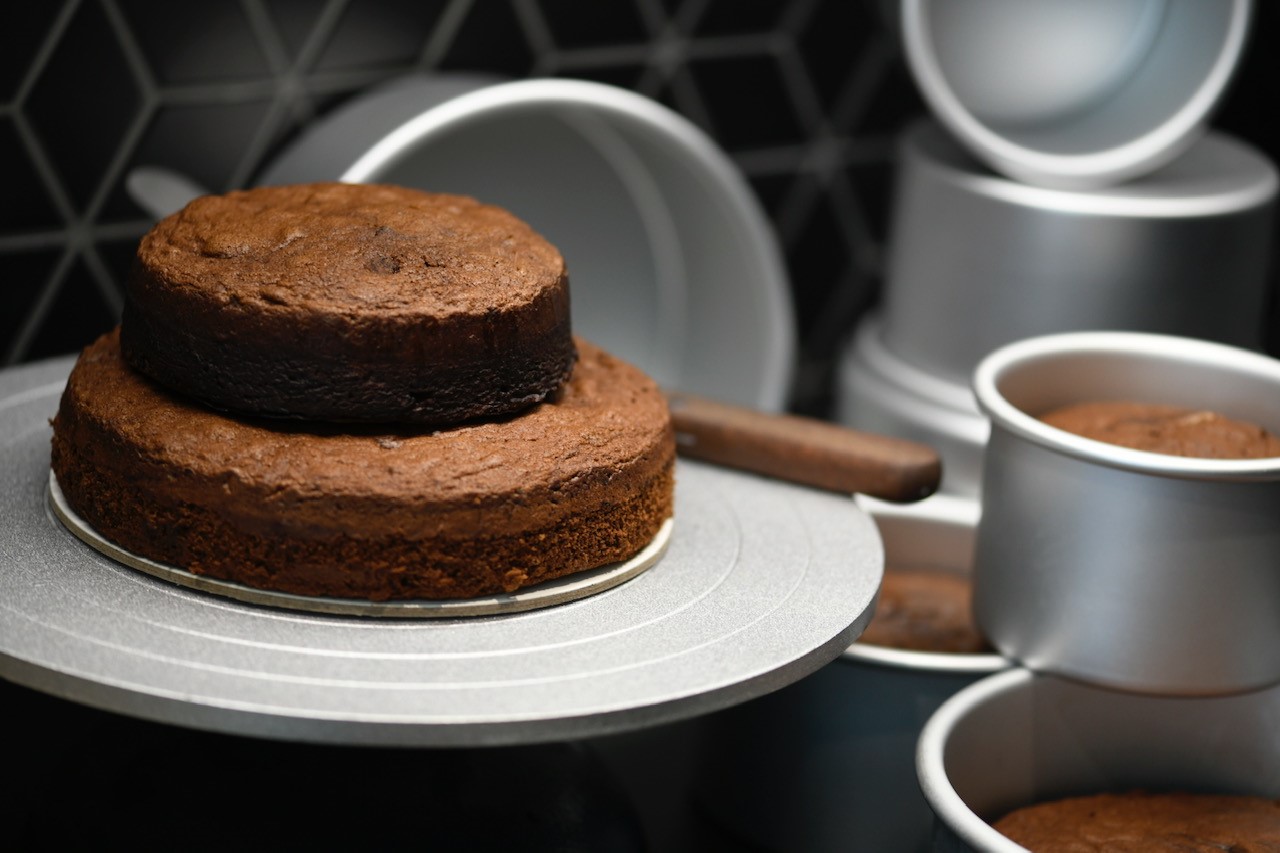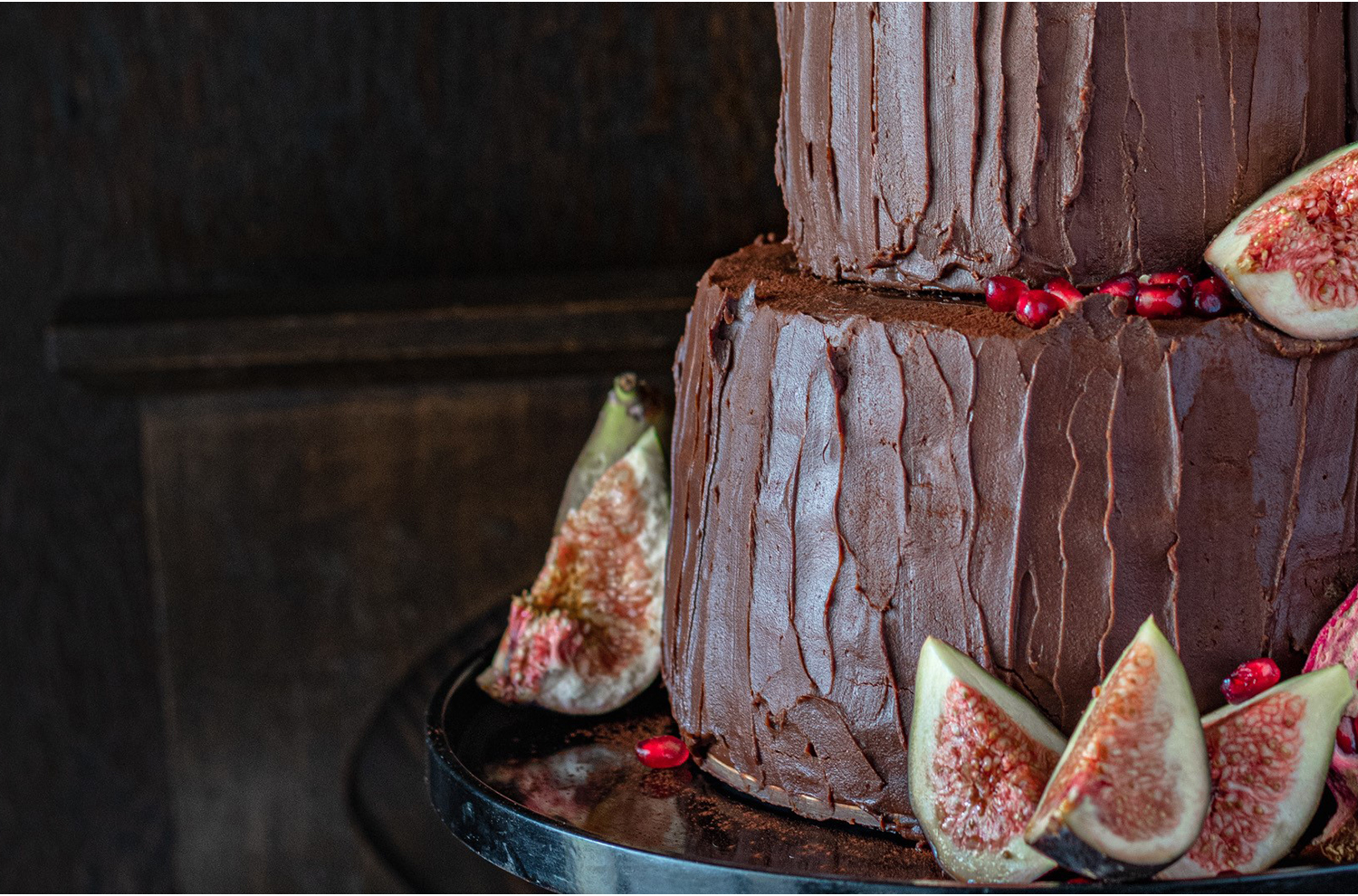Spiced Port, Fig and chocolate layered cake
25th Nov 2020
Photography and Recipe by Claudia Anton, The Sugarologist www.thesugarologist.com
Makes one tall 8 inch cake.
Note: The sponge and the figs can be prepared the day before. Make the ganache the morning of assembly, followed by the macaroon layers and buttercream.
Chocolate genoise sponge
For 2 eight inch deep cake pans
- 140g cake flour
- 40g dutch cocoa
- pinch salt
- 6 eggs (60g each)
- 180g raw caster sugar
- 1 teaspoon vanilla bean paste
- 60g unsalted butter (melted and cooled)
Equipment
- 3 x Bakemaster Silver Anodised Round Deep Cake Pans
METHOD
- Grease tins and line the bottom with greaseproof paper. Dust the sides with cocoa and tap off any excess.
- Mix then sift together the flour and cocoa twice. Mix in the salt.
- Place the eggs and sugar in a heatproof bowl and whisk over a pan of boiling water until they feel warm to touch (around 45 degrees Celsius)
- Transfer the mixture to a mixing bowl with whisk attachment and beat until pale, thick and fluffy, and the mixture leaves a visible trail when when the whisk is lifted from the bowl.
- Gently fold in the flour mixture and vanilla bean paste using a large metal spoon or spatula. I like to whisk a little of the flour over the eggs and then fold as I go.
- Take off half a cup of mixture and mix it with the cooled butter. Fold this into the batter until just combined.
- Divide carefully between the two tins.
- Bake at 170 deg C fan forced until risen and springy in the middle but not too dark. (around 15 minutes).
- Cool in the tin for about 15 minutes, then invert and wrap carefully in plastic wrap.
- Allow the wrapped cake to rest overnight.
- The next day, level the tops and cut each cake in half prior to stacking.
Ported Spiced figs
- 4 star anise
- 1 cinnamon stick
- two grinds of black pepper
- zest of one orange
- 6 cardamon pods, crushed
- 1/2 cup raw sugar
- 1 cup port
- 500g fresh figs (ripe but firm)
- Place a large, heavy based saucepan over medium/high heat.
- Once hot, sprinkle the sugar over the base and cook until it starts to form a dark caramel. Swill the pan as you go to distribute the caramel and prevent burning.
- Remove from the heat and add the port and the spices. Allow the mixture to bubble and dissolve most of the caramel.
- Cut the figs in half from stem to base. Place them in the syrup and simmer over low heat for 4-5 minutes with the lid on until just soft. Turn off the heat and allow them to cool in the liquid. Store in the fridge until ready to use.
Dark chocolate ganache
- 200g dark chocolate (callets or broken into small pieces)
- 200g cream
- 40ml kirsch
- 15g unsalted butter
- Heat the cream until it is just starting to boil.
- Place the chocolate in a heatproof bowl and pour over the hot cream.
- Allow to sit for 2 minutes, then mix with a spoon until the chocolate and cream have combined.
- Mix in the kirsch followed by the butter until smooth and glossy.
- If the ganache separates, add a little cold cream and stir again to combine.
- Allow to set until thickened and spreadable (this can take several hours)
Hazelnut macaroon layers
- 6 egg whites
- a pinch of cream of tartar
- 300g caster sugar
- 200g hazelnut meal
- 1 tsp vanilla bean paste
- Start by marking out three 8 inch circles onto baking paper using the bottom of the cake pans as a guide. Turn the paper upside down and place on a tray.
- Beat the egg whites with the cream of tartar, using a whisk attachment, until you have soft foamy peaks. Sprinkle over the sugar gradually while beating, and continue to beat until the sugar has dissolved and the mixture is glossy and thick. Beat in the vanilla bean paste. Fold in the hazelnut meal until combined.
- Transfer the mixture to a piping bag with a large round hole (diameter as least 1 cm).
- Secure the paper onto the trays with a dot of mixture.
- Pipe rounds of macaroon onto the baking paper, keeping the rounds just inside the lines of the circles.
- Once you have three rounds, pipe any extra mixture into small macaroon biscuits.
- Bake the macaroons layers at 100 degrees celsius for 90 minutes. Turn off the oven and allow to cool in the oven for a further 30 minutes. Remove the backing paper carefully. Put aside until ready to assemble the cake.

Chocolate German Buttercream
- 750ml full cream milk
- 2 teaspoons vanilla bean paste
- 150g caster sugar
- 6 egg yolks
- 50g cornflour
- 30g dutch cocoa powder
- 375g cultured unsalted butter (soft)
- 55g good quality dark chocolate
- Heat the milk in a saucepan with the vanilla and cocoa until just about to boil.
- In the meantime whisk the egg yolks and the sugar until creamy. Whisk in the cornflour.
- Add the hot milk mixture and whisk to combine. Return everything to the pan and bring to boil, stirring constantly, then allow to boil for a further 2 minutes.
- Empty the custard into a bowl and cool down by placing it in a sink full of iced water. Keep stirring intermittently while it is cooling to stop a skin forming. Alternatively, cover in cling film so it is touching the top of the custard and allow to cool in the fridge. The custard need to be at room temperature but not cold.
- Melt the chocolate and allow it to cool to room temperature.
- Whip the butter using the paddle attachment on a stand mixer until white and fluffy.
- Whilst still beating, add the cooled custard, a tablespoon at a time, beating after each addition. Continue to beat until well combined and fluffy.
- Beat in the cooled chocolate until well combined and set aside the buttercream.
Dark chocolate ganache
- 200g dark chocolate (callets or broken into small pieces)
- 200g cream
- 40ml kirsch
- 15g unsalted butter
- Heat the cream until it is just starting to boil.
- Place the chocolate in a heatproof bowl and pour over the hot cream.
- Allow to sit for 2 minutes, then mix with a spoon until the chocolate and cream have combined.
- Mix in the kirsch followed by the butter until smooth and glossy.
- If the ganache separates, add a little cold cream and stir again to combine.
Allow to set until thickened and spreadable (this can take several hours)
100g dark chocolate – for chocolate decorations (optional)
Extra figs for decoration
Pomegranate seeds and segments for decoration (optional)
Acetate sheets
To assemble:
- Halve the sponges
- Drain the figs and cut into smaller pieces. Reserve the syrup.
- Stack the cake in layers on a cake board or round platter as follows:
- Start with sponge, drizzle with a little syrup and top with a layer of figs followed by a layer of buttercream.
- Top with a macaroon disc followed by another layer of buttercream.
- Continue stacking with sponge, fig, buttercream, macaroon and buttercream layers.
- Finish with a sponge layer, ensuring the flat side is on top of the cake.
- Spread a thin layer of buttercream around the cake to fill and smooth any gaps and act as a crumb coat.
If the cake feels a-bit wobbly, place a collar of acetate around it to stabilise.
Chill until firm (ie overnight or several hours at a minimum)
Cover the cake decoratively with ganache, using a palette knife.
Top with cut fresh figs, shards or fans of tempered chocolate and pomegranate.
Note: the cake is even better served the next day.

